Life at the Royal Naval College, Greenwich, during the Second World War
Fri 8 May 20
The Royal Naval College, Greenwich, which from 1873 to 1998 occupied the site previously occupied by the Royal Hospital for Seamen, was the most highly rated naval training college in Europe, with a reputation for academic rigour. During the Second World War it provided training for around 27,000 officers and more junior ranks from Britain, the ‘Dominions’ and beyond.
With the start of World War II, most courses initially ceased or moved elsewhere, but as the War proceeded activity picked up again. The College provided training for recruits to the Royal Navy and for the ‘Reserve’ services drawn from the civilian population: the Royal Naval Reserve (RNR) and the Royal Naval Volunteer Reserve (RNVR). Women were able to join the newly reformed Women’s Royal Naval Service from 1939 and were trained at the Royal Naval College. They became popularly known as the ‘Wrens’.
The first pioneering group of Second World War Wrens joined the Royal Naval College at Greenwich as cooks, motor drivers and telephonists, releasing men for service at sea. Entering a predominantly male environment, they won the respect of their colleagues despite initial scepticism.
WRNS Officer Training was one of the first new courses started at the College after the declaration of war. It is estimated that more than 8500 Wrens trained here between 1939 and 1945.
The WRNS was regarded as one of the most glamorous services and volunteers were rarely in short supply. The early recruits tended to be drawn from women with existing naval connections, and officers were recruited from upper class or professional backgrounds. As demand increased, the WRNS reflected a broader cross-section of society and, as the war progressed, a huge variety of roles were undertaken by Wrens. No longer restricted to clerical and domestic work, they served as meteorologists, radio and cypher operators, despatch riders and signals personnel, among many other roles.
Listen to Jane Eldridge recalling the variety of lectures she attended and how she became a Cipher Officer.
Jane Eldridge was born in Portsmouth in 1920 and served in the Women’s Royal Naval Service (WRNS) from 1941-44. From 1942 to 1943 she completed the Officer Training course at the Royal Naval College and then trained to be a Cipher Officer.
Each day was full of lectures on things I never ever dreamed I was going to talk about or learn about: navigation, running an office, gas protection, first aid, how to be an officer – which was very important as far as I was concerned.
It was full of knowledge, and it was so interesting. They concluded, because you had been tied up with the navy, most of the people who had been accepted then had to be associated with the navy in some way or other and I wasn’t and so I had to learn all about battleships and destroyers. To me, it was the equivalent of going to university – all this.
At the end of the time we were there, they asked you then what you would like to do. Well, I didn’t really know. They said ‘would you like to be mobile or immobile?’ I said mobile and then they gave you a list of things you could do. You could be a secretary or a cipher officer, and I said to them, well what do you think I should do. They said, well you should become a cipher officer. Well I hadn’t a clue what a cipher officer was, no idea, and so then I think I stayed on a week and had a week of learning how to become a cipher officer.
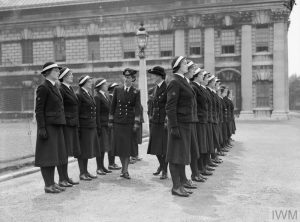
HRH The Duchess of Kent inspecting Cadets of the WRNS Officers’ Training Course, 1941
Princess Marina became Chief Commandant of the WRNS in 1940 and made frequent visits to the Royal Naval College.
© Imperial War Museum [A4433]
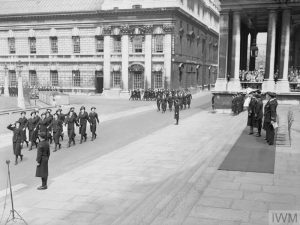
The March Past by WRNS, 1941
Princess Marina became Chief Commandant of the WRNS in 1940 and made frequent visits to the Royal Naval College.
© Imperial War Museum [A4435]
Greenwich was heavily bombed during the War: its location close to the London docks made it particularly vulnerable. The first raid in September 1940 set a ten-mile stretch of the Thames riverside on fire, though the College escaped serious damage. Later that month eight classrooms, office and part of the library were destroyed in the King Charles block. Bombing continued until June 1941 and resumed in December 1942. In 1943 part of the King Charles block was destroyed in a daylight attack, and one officer was killed.
Fire watchers were posted on all the rooftops but living at Greenwich during the heaviest raids was an unsettling experience. This was also the time of incendiary bombs, difficult to deal with due to the complexity of the roof areas. Naval College trainees were on constant watch, and often kept busy at night dousing small fires with fire hoses.
In June 1944, as soon as the V1 (doodlebug) attacks started, roof spotters were positioned in the dome above the Chapel, from where the chapel bell was rung as a warning. Local people quickly made use of this warning, which was relayed further afield by a whistle, hooter or bell. Graffiti carved by the firewatchers is still visible on the wooden walls in the dome.
Listen to Susan Martin recalling the effects of a bomb blast to one of the buildings.
Susan Martin was born in Rangoon in 1923. Susan was a Wren Officer and was sent to Greenwich to study the Officers Training course during the Second World War.
When I came back as an officer to do the training course, we were sent to the Nurses’ home, which I gather is now called Devonport House. We were there, and we were made to sleep in the corridor, which was lucky because when it was bombed, all the windows were shattered. I always remember what a bomb blast does and that was it literally took my husband’s photograph out of the frame, it went down several windows later and came in at another room, so I was able to retrieve it.
Then we were told, after this session, that that wasn’t the only thing the bomb blast had done. It had removed all the officers’ clothes which were then festooned on the trees, and the midshipmen were told to go out and collect them. So it had its lighter moments.
As far as Greenwich itself is concerned, the buildings and everything absolutely impressed one enormously – it was a great privilege to be there. We visited the Queen’s House. It was the Park, and being able to get out into the Park. But we weren’t allowed to go into the town, that was completely out-of-bounds. We really were cocooned, because once again it was secrecy, and they simply did not want you to talk about what you were doing. It was so ingrained in us that we just kept to that.
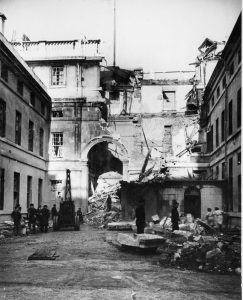
Damage to the King Charles block, 1943
To the far right, two Wrens can be seen stepping over the debris.
© Crown Copyright. Historic England Archive
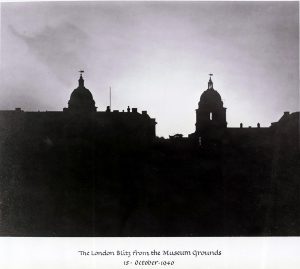
The London Blitz from the National Maritime Museum ground, 1940
© National Maritime Museum, Greenwich, London
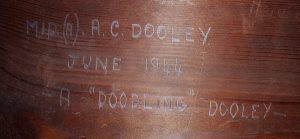
Graffiti carved by the firewatchers is still visible on the wooden walls in the dome
© Old Royal Naval College
The Wrens’ sleeping quarters in the Queen Anne Building were basic but comfortable, with up to nine in a dormitory (known as ‘cabins’) and one bathroom between thirty. Wake up was at 6.30am, when they gathered their belongings and got ready for the day: breakfast, followed by ‘divisions’ (morning parade), roll call, squad drill and then chores, including tidying shelters, laying out and clearing tables for meals.
The warren of corridors and vaults beneath the College were used by the Wrens as air-raid shelters. During the worst raids, the women slept underground, in hammocks or three to a mattress, and worked and attended lectures underground as well.
Former Wrens recall spending up to twelve hours in the ‘dungeon’ – what we now know as the ‘Jacobean Undercroft’, the only part of the old Greenwich Palace still standing. It became their ‘mess’, where they wrote letters to families and boyfriends, and chatted about the day’s events. There was lots of giggling and laughter until lights out at 10pm. When it was safe to spend evenings above ground, they entertained themselves by singing popular songs, watching lantern slides and occasional folk dancing.
Listen to Joan Thomas recollecting her experiences of air raids during the Second World War.
Joan Thomas was born in Brockley in 1929. Her father, Clement Borie, was the Deputy Secretary of the College. She moved to the College in 1941, when she was 12, and lived in the Secretary’s residence in the top corner of Queen Anne Building.
She returned to the Royal Naval College in 1953 as a Wren on the Officers Training Course.
I saw Wrens drilling there [on the ground of the Royal Naval College], practising marching and giving commands. We also shared an air raid shelter with them so, for the first part of the war, I saw them in the middle of the night when everybody had to get up and go downstairs to the cellars and spend the night there.
The Painted Hall itself had great big black-out curtains covering the windows and some of the tennis courts were dug up and devoted to growing vegetables. There were tennis courts… there was one tennis court beside Queen Anne building and then the others were near the western entrance.
During the war, we had a little air-raid shelter of our own, at the bottom of Queen Anne building, and I had to run down 63 steps to get there, and I remember a window crashing in behind me.
The area around the College was badly affected, it was a miracle that the Painted Hall and the Chapel survived. My father spent many nights up on the roof, fire watching and of course they had stirrup pumps beside them ready to extinguish the fire if one occurred. In fact, it was amazing that so little damage did occur inside the College. I think it was only towards the end of the war that King Charles building was hit. Fortunately, only one Commander was killed in that attack. Anyway, it was very lucky that there weren’t more casualties.
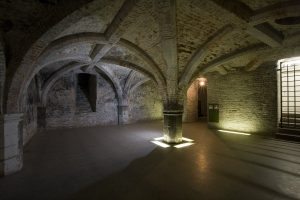
Vaults beneath Queen Anne building
The ‘Jacobean Undercroft’ is the sole remaining intact survival from the royal palace at Greenwich
© Old Royal Naval College
Many wartime Wrens remember the sounds of Greenwich – the trams rattling past the College, the pigeons and the busy traffic on the Thames with sailing barges and naval patrol boats. The town of Greenwich was described as ‘Dickensian’, with cobbled alleys then lit by gaslight. For most of the War, the Officer Training Course lasted three weeks. Many former Wrens describe the sense of being sent to Greenwich to ‘knock off any rough edges’ and ‘learn how to be a lady after your life ‘below decks’’.
In 1944 the situation got so bad that the Officer Training Course was temporarily moved to Stoke Poges in Buckinghamshire. The 200 WRNS ‘ratings’ (from the more junior ranks) who worked in the kitchens at the College remained and continued to serve in very challenging conditions.
Despite rationing, the standard of catering at Greenwich remained high. Breakfast, lunch and dinner were served in the spectacular surroundings of the Painted Hall on long refectory tables. Serving so many people could be slow work, as one Wren recalled, ‘you get your cereal, then wait for sugar of which there are two silver bowls for a table of 120, then wait for milk…’
On arrival one cadet was given an excellent meal of ‘potato soup, lamb, mint sauce, new peas and potatoes followed by strawberries and cream. But it didn’t seem right to be eating that in the fourth year of the War with a white gloved pair of hands to each half dozen of us’. A newspaper article from 1942 even refers to an ice-cream machine that ‘makes delectable and spectacular iced sweets with strictly rationed ingredients’.
However, the privileged rations on offer were partly due to the fact that Royal Navy officers were often sent to Greenwich not just for courses but as a period of recuperation after arduous spells of active duties at sea.
Napkins had to be collected from pigeonholes as the clock struck the hour before taking one’s place in the Painted Hall. Port was served after dinner. On ‘guest nights’ Wrens could invite their family to dine in the Painted Hall, which made them feel very proud.
Listen to Jane Eldridge recalling her memories of dining in the Painted Hall.
Jane Eldridge was born in Portsmouth in 1920 and served in the Women’s Royal Naval Service (WRNS) from 1941-44. From 1942 to 1943 she completed the Officer Training course at the Royal Naval College and then trained to be a Cipher Officer.
You used to go in the little entrance underneath, and you went in and I was shown a little corner with beautifully carved pigeon holes and there you had your table napkin, and your table napkin ring which was ivory, with a number on it and that was yours all the time you were there. You took it out before the meal and then you walked up into the Painted Hall and it was blacked out but was still very beautiful and they even had the silver on the tables. The stewards waited on you with white gloves on and it was just unbelievable, it was so wonderful, it really was.
For breakfast the next morning you came down and nobody spoke – you never spoke at breakfast time.
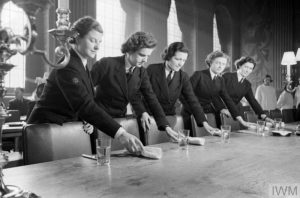
Wren stewards laying the table at the Royal Naval College, Greenwich
© Imperial War Museum [A7474]
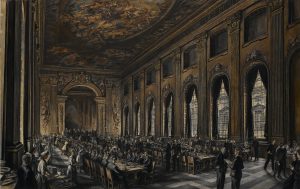
Officers dining in the Painted Hall during the Second World War, by Muiheard Bone, c.1942
Blackout curtains can be seen on the windows.
© National Maritime Museum, Greenwich, London
Most of the people trained at the Royal Naval College during the War were British, but the exceptions included a number of United States citizens who volunteered to join the Royal Navy many months before their country entered the Second World War. Set into the floor of the Painted Hall is a commemorative plaque honouring the (anonymous) ‘First Three’ of these men: in 2001 it was augmented to list the names of 22 Americans who joined the Royal Navy between 1939 and the bombing of Pearl Harbour in 1941.
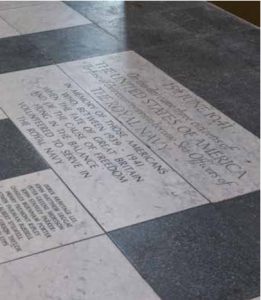
Plaque commemorating the “First Three” American servicemen, 22 Americans who joined the Royal Navy between 1939 and the bombing of Pearl Harbour in 1941
© Old Royal Naval College
Amongst the trainees from other countries was a group of 24 students sent from China to the Royal Naval College in 1943. Upon completion of their training in 1944 they served in the Royal Navy.
On 8 May 1945 at 3pm the UK wartime Prime Minister, Winston Churchill, made a radio broadcast to the British people announcing the end of the War in Europe: Germany had unconditionally surrendered to the Allies the previous day. Widespread celebrations immediately broke out, and the Royal Naval College was floodlit to mark the national outpouring of joy and relief.
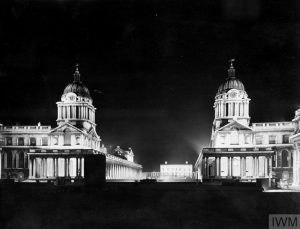
The Royal Naval College at Greenwich was floodlit during VE Day celebrations, May 1945
© Imperial War Museum [A28727]


